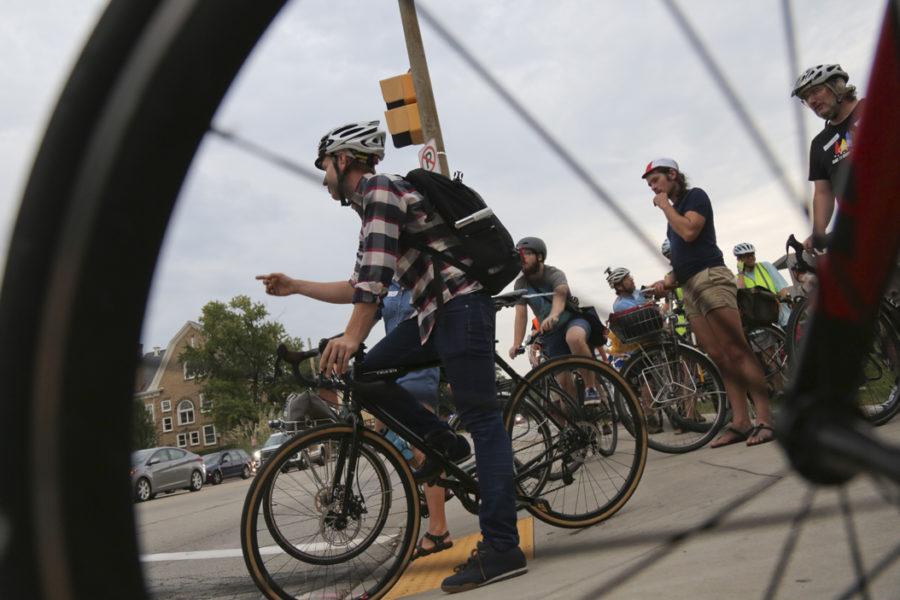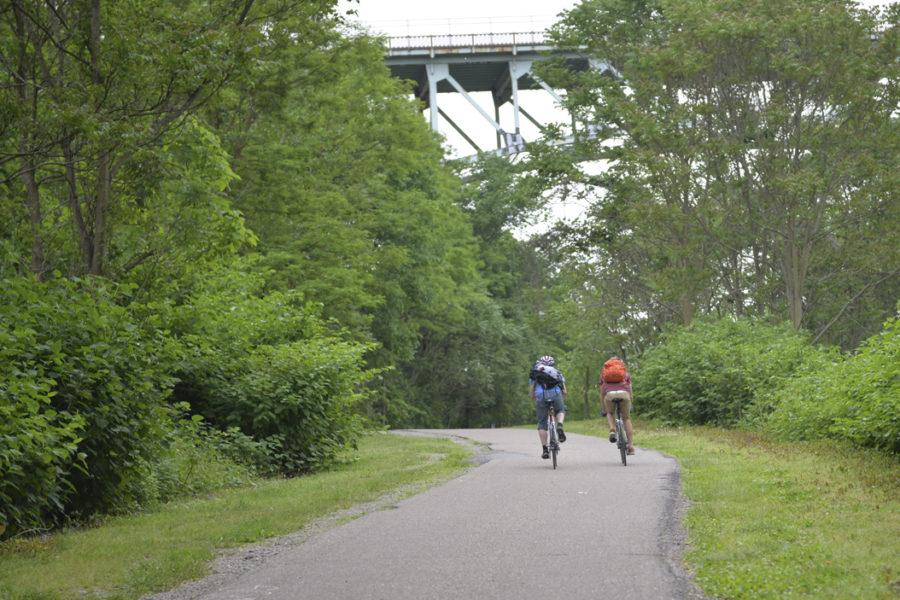Madeline Rigatti’s black boots press forcefully on the steel pedals of her orange Salsa Vaya, propelling the 25-year-old up a short, steep hill by her house.
“I used to hate that hill,” Rigatti, who started commuting by bike in college 5 years ago, said.
Weather permitting, Rigatti commutes from her home by Shadyside Hospital to the Kaufmann Medical Building in Oakland. It’s not a long ride — just over two miles — and it’s uncharacteristically flat for Pittsburgh, except for the short hill that begins the commute. However, Rigatti’s destination is on Fifth Ave., which means the short, flat ride can sometimes turn dangerous.
“Do you ever ride on Fifth?” she asks me as we coast up to a red light. “It’s terrifying.”
After a calming early morning ride through Shadyside, making that right turn onto a four lane road with cars, trucks and buses is a better way to wake yourself up than five cups of coffee. During the ride, Rigatti said there is plenty of room for a bike lane on the right side, but for now all you can do is stay alert and hope drivers do the same.
Sana Chowdhry also commutes outside of a car, but her ride takes four times as long and is on four wheels. She lives in Monroeville, a Pittsburgh suburb that’s usually a short 15 to 20 minute drive from Pitt. But Chowdry takes the bus.
Every weekday, Chowdhry, a senior studying history, global studies and Arabic, catches the Port Authority’s 67 bus from UPMC East, a 10 minute walk from her family’s apartment in Monroeville — maybe a little longer if her building’s old elevators are running slowly that morning.
She boards the 67 as early as 6:30 a.m. if she has an 8 a.m. class and settles in for a hour to an hour and a half ride — snaking through Churchill, Wilkinsburg, Point Breeze and Squirrel Hill before she exits the bus on Pitt’s campus.
“My life and schedule really revolves around the bus,” she said. “I have to make my plans according to the about once an hour the bus comes.”
The 67 makes its first stop at Chowdhry’s bus stop at 5:54, again at 6:24, 6:54, 7:31, 8:21, 9:31, 10:13, 11:13 and so on. The bus doesn’t run to the UPMC East stop at all on weekends, leaving no public transportation options for Chowdhry to get to campus other than the P67 and P12.
The P67 picks up at the mall, which she said requires a car to get to, something she doesn’t always have access to with two siblings sharing the vehicle. The P12 stop is closer, but says she doesn’t feel safe crossing the several busy roads — roads where drivers don’t typically look out for pedestrians on.
“In Monroeville and other suburban areas everybody is in this habit of just driving anywhere,” she said adding that “the culture” of the suburbs doesn’t emphasize “eco-friendly” transportation, which is important to her.
About 18 percent of Pittsburghers commute by public transportation and another 2 percent by bike, according to the U.S. Census 2015 American Community Survey. Both Rigatti and Chowdhry represent the non-ideal trips many of these car-free travelers take to get where they’re going.
From 2000-2015, the number of people who bike to work increased by 56.7 percent nationwide, according to the Census, a trend that is amplified in Pittsburgh. Over those 15 years, the number of Pittsburghers who get to work by bike has increased by 284 percent, with 1.7 percent of the city currently commuting by bike. While this number is down from 2 percent in 2013, it still puts Pittsburgh as the 15th most popular city in the U.S. to pedal to work.
Rigatti, like many other commuters, rides to work for convenience and to save money. She doesn’t like the bus controlling her schedule and can’t stomach the $200 per month for a parking pass in Oakland.
Along with the convenience and savings, Rigatti likes riding to work for the exercise and fresh air. However, she is worried about the safety of sharing roads — especially Forbes and Fifth avenues — with cars, trucks and buses zipping past.
In 2015, 71 cyclists were involved in crashes on Pittsburgh roads. One of those riders, Pitt professor Susan Hicks, was killed at the intersection of Bellefield and Fifth avenues in October 2015. In 2016, another cyclist died in a crash on West Carson St., a road that advocates at BikePGH say is unsafe and called on the city to make more bike friendly after Dennis Flanagan’s death on the narrow road along the Ohio River.

Rigatti went to a BikePGH forum on April 4 in the William Pitt Union to learn how to make her commute safer and less stressful.
“It’s kind of scary — biking in Pittsburgh,” Rigatti, a Pitt research project coordinator, said. “I came to learn how to make it safer.”
Julie Mallis, education programmer at BikePGH, told the group of a dozen riders at the event that the geography and roads of the city add to the difficulty of using a bike to get around.
“Pittsburgh is like piles of spaghetti thrown down,” she said. “Those are the roads”
Kevin Stiles, leasing and support services manager at Pitt, gave one potential solution at the forum: “geeky clothes” — such as neon yellow jackets, blinking lights and reflective armbands, the help rides be more visible.
“I personally think neon clothes, flashing lights are cool,” not geeky, Mallis responded.
BikePGH is a Pittsburgh bike advocacy group that works for better infrastructure for bikes and increasing safety through educating riders and drivers. Of those goals, BikePGH Executive Director Scott Bricker says that infrastructure is by far the most important.
Bricker said increasing bike infrastructure directly increases ridership and moves commuters from car to bike. Good infrastructure also provides a safe, affordable and environmentally friendly way to get around, he said.
“You look at Fifth and Forbes avenues and you’re like, ‘no thank you,’” Bricker said. “You add some protective bike lanes to those streets and all of a sudden lots of people are like, ‘Oh that’s great, I could totally do that. I have a safe place to bike.’”
He isn’t concerned with bike lanes potentially increasing traffic on roads like Fifth because he thinks safe infrastructure will equate to less drivers and more riders. Additionally, Bricker said bike lanes and better pedestrian infrastructure makes the road safer for drivers as well as riders.
“This is about saving lives,” he said. “[Bike lanes] actually should take more cars off the road.”
Another advantage to a bike lane on Fifth Ave., Stiles said, is that less lanes might force cars to slow down.
“I don’t know that we need a highway in the middle of campus,” he said. “If there were less lanes it would kind of force cars to go a little bit slower. I think the speed limit is 25, but I don’t know the last time I saw someone going 25.”

A bike lane through the Forbes-Fifth corridor is not just a long-shot goal of bike advocates — it will likely be a reality if Pittsburgh completes the newly proposed Bus Rapid Transit system.
Almost 20 percent of Pittsburghers commute by mass transit — the vast majority by the Port Authority’s bus system, which had an average weekday ridership of 179,361 during the fiscal year 2015.
Molly Nichols, director of Pittsburghers for Public Transit — a group that advocates for improved public transit in the city and county — said there is still work to be done to improve the commutes of people like Chowdhry.
“While we have a good backbone of frequent transit service in our city, there’s still a lot of need for improved public transit, especially throughout the whole county,” she said. “It still can be very difficult for people without access to a vehicle to get around with public transit.”
This BRT system proposed in March will better connect Oakland and Downtown, and will directly affect 30 percent of Port Authority riders, according to Mayor Bill Peduto — who campaigned in 2013 on expanding the city’s light rail system. The system will feature electric buses, new bus shelters, bike lanes and dedicated bus lanes that will cut the average travel time from Oakland to Downtown from 18 minutes to 10, according to the city’s proposal.
Cutting eight minutes off a commute is a nice perk, but Carnegie Mellon researchers found — in a report prepared for the Port Authority about BRT — the length of the trip between Oakland and Downtown is not currently a concern.
“Speed of service from boarding to destination is not an issue in the corridor,” the report said, but noted that some riders were dissatisfied with the frequency of buses.
The BRT system will run from Liberty Ave. Downtown to the Cathedral of Learning, with various proposed branching lines running to Squirrel Hill, East Liberty and Wilkinsburg. Unfortunately, for people that commute from more distant neighborhoods on the 71 and 61 lines — like Braddock, Homestead and Regent Square — the new system might make their commute worse, according to Nichols.
“This bus rapid transit project,” Nichols said with a sigh. “We see that there are opportunities there … but we are also very concerned with the impact on the riders who would be forced to transfer in Oakland.”
The 61 and 71 lines that currently run through Oakland will terminate in Oakland under the BRT plan, forcing 3,000 to 7,000 riders to transfer, depending on the chosen route. This transfer won’t lengthen the total ride time, according to Port Authority Public Relations Representative Adam Brandolph, because the ride time from Oakland to Downtown will be seven minutes shorter.
“The problem with that claim,” Nichols said, responding to the Port Authority’s position. “Let’s say you’re on the 61A which goes to Braddock. It’s gonna come less frequently.”
During rush hour, the 61A currently comes every 15 minutes. This frequency will be halved to every hour with some of the BRT proposals, Nichols said. This isn’t as much of an issue going inbound, she said, because a rider could time it right leaving Braddock and then hop on the BRT in Oakland. However, going outbound a rider could take the BRT to Oakland and just miss their bus by a minute, leaving them 29 minutes to spend waiting for their bus, but in a shiny new bus stop.
In addition to the hassle of an extra transfer, Brandolph said there is no further information on the possibility of a transfer fee for BRT riders as of April 17. In an interview with The Pitt News, Peduto said the BRT must be implemented in a way that doesn’t make the system inaccessible.
“You want to … keep it within cost constraints — especially for lower-income people,” he said.
The BRT is still being developed, Nichols pointed out, so we don’t know exactly how much the frequency of the local service or transfer fees will change.
“Over the next few months, we plan to engage the public once again, and that discussion will include fare policy,” Brandolph said.
While groups like BikePGH and Pittsburghers for Public Transit focus efforts on creating better infrastructure, Stiles, who rides to work for convenience and mental health, sees the solution to better car-free transportation as a more individual effort.
“I don’t know if [improving safety] is city [responsibility] or if it’s individuals,” he said. “Sometimes [drivers] beep at me and I’m really not sure why. I feel like they’re jealous I’m getting somewhere faster than they are.”
He said his Trek Avant, upright and outfitted with fenders and lights, gets him where he needs to go happier and faster than if he drove or took the bus. Stiles said he wishes drivers frustrated with bikes would try commuting on two wheels.
“Life really can be better,” he said.


